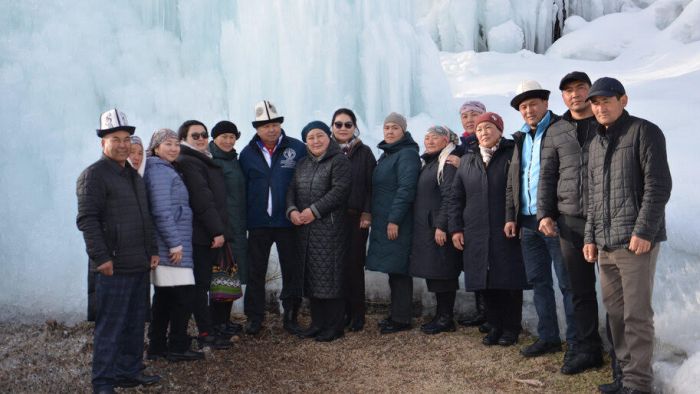The artificial glacier project uses climate-smart agricultural practices to preserve and sustain common natural resources
Manzura Orolbaeva greets guests with baked bread and a saucer of melted butter in accordance with Kyrgyz custom. On their farm, they grow the grains for their bread, and the cows they raise provide the butter.
In the southern Kyrgyzstan mountain village of Kara-Dobo, where it is difficult to grow crops due to the dry environment and lack of fertile ground, agriculture provides the majority of the local population’s food and income. Access to water is extremely difficult.
The nearest water source for Manzura is a mountain spring two kilometres away. This 63-year-old woman and her family members go there and back multiple times each day to bring back enough water for the inhabitants of their farm, as well as for the animals and plants.
“You can live without gas; you can live without the internet, but you cannot live without water,” Manzura remarked.
In this area of little rainfall, water is scarce not only in Kara-Dobo but also in many neighbouring communities. The weather is frigid with little to no snow in the winter and hot and dry in the summer. Mountain springs are the primary water sources, however, they are frequently located in inaccessible locations.
You may also like to read: Enabling climate-resilient agriculture with agritech
As a high-altitude country, Kyrgyzstan has been experiencing the effects of climate change acutely. Variations in temperatures are leading to unreliable precipitation patterns and more frequent peaks in temperature are causing aridity and drought, especially in mountain pastures.
To increase the communities’ resilience to these weather anomalies, experts from the Food and Agriculture Organization of the United Nations (FAO) proposed the construction of an artificial glacier in the region as part of the “Shared prosperity through cooperation in border regions of Kyrgyzstan and Uzbekistan” project.
Funded by the United Nations Peacebuilding Fund (UNPBF), the project is implemented jointly by FAO and the United Nations Population Fund (UNFPA) and is aimed at enhancing cross-border environmental and socio-economic cooperation between Uzbekistan and Kyrgyzstan; it also works to build confidence and trust between local governments, communities and civil society organisations. The project uses climate-smart agricultural practices to preserve and sustain common natural resources.
According to Manzura Orolbaeva, many people laughed at the concept of an artificial glacier, but the people of Kara-Dobo village were in favour of the plan.
Everything dries up in the gardens if we don’t water them. Manzura said, “We won’t have enough left over to pay our bills or feed our livestock.
You may also like to read: Embassy of Israel in India and The Circle FC partner to foster innovations that solve water-related challenges
With FAO’s technical and financial assistance, the villagers carried out the construction themselves. An underground pipeline was first put in place before the artificial glacier could be built. 55 individuals laboriously dug a trench and laid pipes from the mountain spring to the pasture where their animals grazed in just one week. The pipe’s tip was then elevated to a height of 20 metres.
While these works were going on, Manzura’s house became a type of “headquarters” where the villagers planned the course of work. She treated everyone who dug the trench with tea and homemade pastries.
In the winter, the glacier was born. The water from the pipe began to freeze and slowly turn into a huge ice tower. Then in the summer months, the mountain of ice slowly melts, providing residents with regular access to fresh water for irrigation and for their own use.
During the first winter, the glacier grew to more than 70 thousand cubic metres of ice. That’s enough water to fill the size of 100 football fields.
You may also like to read: Human activity around lakes depletes groundwater more than climate change; reveals study
“Now our experience interested residents of other villages, who at first did not believe us,” said Manzura. “Perhaps next year in our area there will be other artificial glaciers. Because water is life,” she added.
Local authorities plan to install one more glacier from their own funding sources and include the expenses in the local budget plan.
In Kyrgyzstan, FAO is supporting several projects to address water scarcity and help villagers use it judiciously. For example, an electronic system for measuring the volume of irrigation water has been recently introduced, with technical and financial assistance from FAO, in the Kochkor district of the Naryn region of Kyrgyzstan. Digital technologies like these have not only helped in the rational distribution of water but also eliminated conflicts among farmers over this vital resource.
“Water is life; water is food. It is a driving force for people, economies and nature and the foundation of our food systems. But this precious resource is not infinite. In the run-up to World Food Day on October 16, we take the opportunity to thank the #FoodHeroes who are taking #WaterAction to manage water wisely, while providing food for us now and in the future – leaving no one behind,” FAO said.





